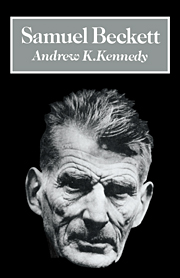4 - Krapp's Last Tape
Published online by Cambridge University Press: 23 February 2010
Summary
Krapp's Last Tape (1958) represents two major changes in the formal evolution of Beckett's plays. It is the first embodiment of the isolated person and mind in a new form of monodrama: one character enacting a kind of dialogue between his old and younger selves. And it is the first use of the tape-recorder as the structural pivot of the play. (The tape-recorder was such a recent invention that Beckett had not even seen one at the time the play was written; the opening stage directions provide for a setting in the future, so as to foil the objection that youn Krapp could not possibly have tape-recorded his birthday memoirs.) We see, then, a further diminishment of drama as traditionally conceived (in terms of character and action) alongside an ingenious new development in dramatic technique, leading to both initial surprise and final effectiveness in the play.
While the formal innovation just mentioned cannot be separated from the emotional power of the play, we need to reflect, first of all, on the human situation that this short play dramatises. The essentially simple existential elements are those found elsewhere in Beckett's work: the deepening isolation of the self, the mind, in the course of a lifetime. Young Krapp still has a whole galaxy of illusions to prop up his vanity: company, glimpses of beautiful women with ‘incomparable’ eyes or bosom; plans of writing something great – a magnum opus; the luxury of judging his still younger self from newly reached moral heights; and the capacity for experiencing a great ‘vision’, expressed in high-toned lyrical prose and recorded in a sonorous voice with undertones of intellectual pride.
Information
- Type
- Chapter
- Information
- Samuel Beckett , pp. 67 - 75Publisher: Cambridge University PressPrint publication year: 1989
